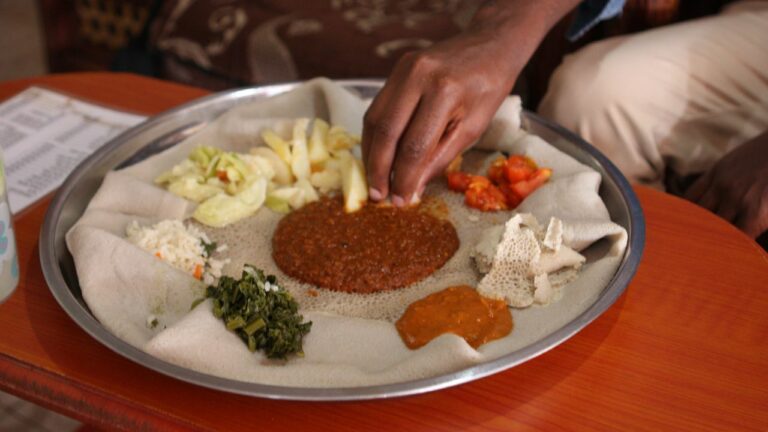Introduction: Why Explore Ethiopian Cuisine?
Ethiopian cuisine is a unique and flavorful experience that has been enjoyed for centuries. Its rich history, diverse ingredients, and distinctive cooking techniques make it one of the most intriguing and sought-after cuisines in the world. The cuisine holds a special place in African culture, as it is considered one of the oldest and most important culinary traditions on the continent. It’s a window into the culture and tradition of Ethiopia, and it reflects the natural resources and cultural diversity of the country.
Ethiopian Cuisine: A Melting Pot of Flavors
Ethiopian cuisine is known for its vibrant colors, bold flavors, and unique textures. The cuisine is a fusion of different cultures and traditions, which has created a unique and diverse culinary experience. Ethiopian cuisine is characterized by its use of spices and herbs, as well as the variety of ingredients used in each dish. Some of the most popular Ethiopian dishes include Doro Wat, Kitfo, and Tibs. These dishes are often served with Injera, a sourdough bread made from teff flour, which is a staple in Ethiopian cuisine.
Spices and Herbs: Key Ingredients in Ethiopian Cuisine
Spices and herbs play a key role in Ethiopian cuisine. They are used to add flavor and depth to dishes, and they are often blended together to create unique spice blends. Some of the most commonly used spices in Ethiopian cuisine include berbere, a spicy blend of chili peppers, garlic, ginger, and other spices, and mitmita, a fiery blend of chili peppers and spices. Herbs such as rosemary, basil, and thyme are also used to add flavor to dishes.
The Ethiopian Bread: Injera
Injera is a sourdough bread made from teff flour, a grain that is unique to Ethiopia. It is a staple in Ethiopian cuisine and is used as a utensil to scoop up food. Injera is made by fermenting teff flour with water and then cooking it on a griddle. It has a tangy and slightly sour flavor and is an essential component of Ethiopian cuisine.
Signature Ethiopian Dishes: Meat and Vegetarian
Ethiopian cuisine offers a wide variety of dishes, both meat-based and vegetarian. Some of the most popular meat dishes include Doro Wat, a spicy chicken stew, and Tibs, a stir-fry of beef or lamb. Vegetarian dishes are also highly regarded in Ethiopian cuisine, with dishes such as Shiro, a chickpea stew, and Misir Wat, a spicy lentil stew, being popular choices.
African Cuisine: Regional Diversity and Common Features
African cuisine is incredibly diverse, with each region having its own unique culinary traditions. However, there are some common features that can be found in many African cuisines, such as the use of grains and legumes, spices and herbs, and a reliance on fresh, seasonal ingredients.
East African Cuisine: Similarities with Ethiopian Cuisine
East African cuisine shares many similarities with Ethiopian cuisine, particularly in the use of spices and herbs and the reliance on grains and legumes. Some of the most popular dishes in this region include Ugali, a maize meal porridge, and Pilau, a spiced rice dish.
West African Cuisine: Differences with Ethiopian Cuisine
West African cuisine differs from Ethiopian cuisine in several ways. The cuisine is heavily influenced by traditional ingredients such as cassava, yams, and plantains, and is often characterized by dishes that are rich and flavorful. Some of the most popular West African dishes include Jollof Rice, a spicy tomato-based rice dish, and Fufu, a starchy dough that is often served with soup or stew.

